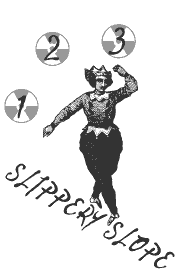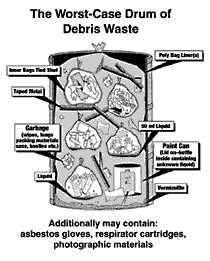
|
This permit, issued by the New Mexico Environment Department (NMED), regulates mixed waste at WIPP. Mixed waste is radioactive waste that is mixed with hazardous materials like solvents and mercury. Most of the WIPP waste is mixed waste. The permit regulates how these wastes are handled and packaged at sites that ship waste to WIPP and limits what can go to WIPP. The mixed waste permit for WIPP went into effect on November 26, 1999. Even before the permit was in effect, DOE filed suit against five provisions of the permit. Although the courts have not yet ruled on these provisions, DOE and NMED held secret meetings and agreed among themselves that four provisions would be changed by permit modification. WHAT ARE PERMIT MODIFICATIONS? By law, mixed waste dumps like WIPP must have a permit that regulates their operations. (This permit regulates only the hazardous part of the mixed waste.) A permit can be approved only after review by the regulatory agency (NMED) and public hearings in which citizens comment and technical experts testify and are cross-examined. Changes or modifications to the permit must also go through a public process. CLASS 1 MODIFICATIONS are minor changes on the level of typographical errors or the names of personnel, phone numbers, etc. There is no public comment allowed on Class 1 modifications and the public is not even informed of them until after they are approved. CLASS 2 MODIFICATIONS are more major changes and require public notice and a 60-day public comment period. CLASS 3 MODIFICATIONS require public notice, comment for at least 60 days and full public hearings. THE CLASS 1 MODIFICATION DOE shipped waste to WIPP before getting a permit. This waste did not pass permit regulations but was "self-regulated" by the DOE. The original permit had a condition which prevented putting waste that had been approved under the permit in the same rooms with this self-regulated waste. During the original permit hearings the Hearing Officer considered this permit condition to be "...the most controversial and provocative issue raised in the proceeding." and said "...that it...is necessary to protect public health and the environment, is beyond serious dispute." NMED itself also stated that this condition was necessary to protect human health and the environment. There was extensive testimony on this condition from all sides and Parties to the hearing were even requested to write a special report it on it. The language of the Class 1 modification is exactly the same language as that previously proposed by DOE during the original permit hearings and rejected by NMED at that time. Now, however, even though the delay until new rooms are available will only be a few months, NMED has approved this very controversial change as a Class 1 modification?putting it on the same level as a typo?with no public participation, comment or even notification that DOE had submitted it. PROTEST THE TAKING AWAY OF YOUR RIGHTS It is more important to protest the process of approving this Class 1 modification than anything else you could do during this comment period. NMED has given indications that it might reconsider its actions on this modification and the level of public protest will definitely affect its decision. Clearly the modification should be at least a Class 2 and probably even a Class 3. For DOE and NMED to work together to bypass public participation is outrageous and is only the beginning of the slippery slope of allowing anything at all into WIPP. (Officials are already suggesting that if the proposed high level waste dump at Yucca Mountain, Nevada isn't approved?a good possibility?WIPP would be a good place for the thousands of used fuel rods from the nation's nuclear reactors.) UNACCEPTABLE CLASS
2 MODIFICATIONS: 2. No sampling for VOCs in the headspace of containers if information about the waste generating process shows that the waste doesn't contain VOC-related hazardous wastes. VOCs (Volatile Organic compounds) are mostly fumes from solvents in the waste. This modification is unacceptable because there is actually very little information in the records on the hazardous part of the waste. Therefore, records could indicate no VOCs in the waste when in fact, they were actually present. ACCEPTABLE CLASS
2 MODIFICATIONS: 1. Alternate method for groundwater testing: Instead of measuring gross alpha and beta radiation in water samples taken to see if WIPP is leaking, DOE proposes measuring specific radionuclides that are at WIPP like plutonium and americium. 2. Sampling for volatile organic compounds (VOCs) Taking one large sample instead of 3 small samples when testing for VOCs in homogeneous waste. 3. No sampling for VOCs in the headspace of containers if the waste was thermally processed. Heating the waste to a high enough temperature will cause all the VOCs to evaporate. 4. Revise criteria for demonstrating the accuracy of the procedures and instruments used to measure cresols and pyridine These compounds are semi-volatile organic compounds (SVOCs) but the permit incorrectly used data for VOCs. This modification would substitute the correct data.
Written comments will be considered by NMED. All written comments should be sent to Steve Zappe, New Mexico Environment Department, 2044A Galisteo Street, Santa Fe, NM 87505. They can also be submitted by e-mail at steve_zappe@nmenv.state.nm.us. To be sure your comments are considerred they must be received by June 8th. (Comments on some modifications can be received as late as June 25th. Check the NMED website for more details.) For more information on the permit and the permit modifications read summaries of the original permit hearings at CCNS's site www.nuclearactive.org. Also check out NMED on WIPP at www.nmenv.state.nm.us and DOE on WIPP at www.wipp.carlsbad.nm.us. You can also call DOE at 800-336-9477 or NMED at 505-827-1560 extension 1013. This flyer was prepared jointly by CARD, CCNS, Nuclear Watch, Peace Action, and SRIC
Oppose DOE's Plan to Expand WIPP
|

 HOW
TO COMMENT
HOW
TO COMMENT